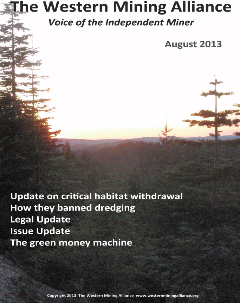Tuesday, October 01 2013
Whether you live in California and want to fully understand how your dredging rights were banned beginning several years ago, or live elsewhere and hear the story so you can prevent it from happening in your state, the following exerpt from the Western Mining Alliance newsletter explains the history of suction dredging, how the California ban was put into effect, and about the Coho Salmon's role in all this... How They Banned Dredging It’s interesting to deconstruct how the dredging ban came about. It’s a good study in how the environmental groups, with the support of the government regulators, used fabricated information to declare an emergency; labeled suction dredgers as destructive to the environment and convinced the State to spend millions of dollars to ban dredging and then to pursue this ban in court. To fight and win this dredging ban we must first understand how they succeeded in banning dredging. By “they” we mean the coalition of environmentalists and government regulators acting in concert to defy Congress and your Constitutional rights. Suction dredging began in the 1950’s. The advent of underwater breathing apparatus by Jaques Cousteau in the 1940’s was quickly adopted by placer miners as a means to reach areas previously passed over by miners. The rivers had been relatively untouched by miners because of the difficulty working underwater. The new ability to work the bottoms of rivers led to the quick expansion of suction dredging throughout the State of California and western rivers. In the 1950’s suction dredging was completely unregulated. Regulation began in 1961 when the California legislature passed SB1549 which was focused on the effects of suction dredging on salmon. The first dredging regulations were published in 1962 and the Department began issuing permits in 1962, however, the possession of a permit wasn’t mandatory. The dredging regulations were the result of a study commissioned by the Department of Fish and Game in 1960 which indicated some restrictions were required to protect spawning salmon. The report also recommended the maximum size of the suction dredge be restricted to a 8” nozzle size. From 1960 to 1994 dredging and dredging regulations remained largely unchanged but in 1994 the Department completed their first environmental impact report which resulted in further restrictions on locations, times and equipment and made the possession of a permit mandatory. An environmental impact report is required by the California Environmental Quality Act (CEQA) for all projects after 1973. Suction dredging was a project subject to permitting prior to 1973. By the law it was exempt from CEQA. The time to fight CEQA was 1993 but there were few of us that had heard of or understood CEQA to the degree we do today. Regardless, by the law, suction dredging is exempt from CEQA and there are sufficient court case rulings that affirm this. The miners grudgingly accepted the new regulations and within two years the Department of Fish and Game was already in the process of creating a new EIR and a new set of regulations. Once the CEQA door was opened and the environmental groups realized they could use their favorite tool to ban dredgers from the rivers they began their assault on dredging. An organization of miners, including Public Lands for the People, challenged the Department over this new effort and the Department dropped the new EIR and left the 1994 regulations intact. The environmentalists, knew suction dredgers were an easy target. As opposed to large businesses, and industries with coalitions and lawyers, we were largely undefended. Being largely solitary operators focused on our efforts to recover gold we didn’t understand CEQA, nor did we care to. While we were busy with our heads down in the river, the environmentalists were petitioning the Department to ban suction dredging and to conduct a new EIR. Click here to download the 21-page .pdf. You will find the full article on the dredging ban on pages 13-15, but with so much good information, you'll want to read every page.
|
|
Nugget of News Blog |






